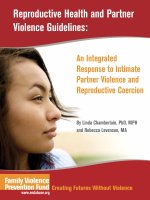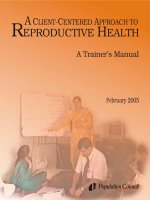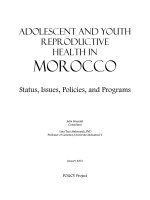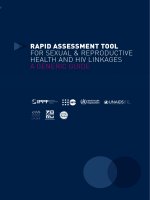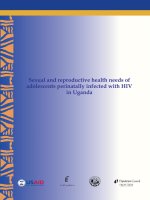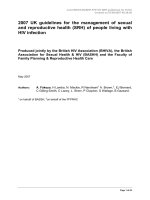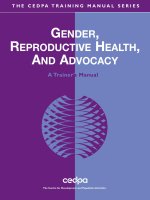REPRODUCTIVE HEALTH, UNMET NEEDS AND POVERTY doc
Bạn đang xem bản rút gọn của tài liệu. Xem và tải ngay bản đầy đủ của tài liệu tại đây (14.07 MB, 601 trang )
REPRODUCTIVE HEALTH,
UNMET NEEDS AND POVERTY
ISSUES OF ACCESS AND QUALITY OF SERVICES
REPRODUCTIVE HEALTH,
UNMET NEEDS AND POVERTY
ISSUES OF ACCESS
AND QUALITY OF SERVICES
Edited by Susana LERNER
and Éric VILQUIN
Committee for International Cooperation
in National Research in Demography
Paris
2005
Chapters in this volume originate from papers presented at an interregional
seminar held in Bangkok, 25-30 November, 2002, in collaboration with the
College of Population Studies (CPS), Chulalongkorn University. The seminar
was organized by Susana Lerner who also acted as scientific editor for the
present volume with the assistance of CICRED series editor Eric Vilquin.
The seminar and this publication have been supported by the United Nations
Population Fund (UNFPA).
Additional English editing and translation by James Walker.
Cover by Nicole Berthoux (INED)
Cover photo: Lourdes Almeida
About the photo: the photograph was taken in rural Oaxaca (Mexico) in 1992
in the house of the Velasco-García peasant family, five hours after the birth
of the baby being fed by the mother. The delivery took place on the same cot
with the assistance of the grand-mother also shown on the picture.
First published in 2005 by CICRED
Copyright © 2005 by CICRED
CICRED
Committee for International Cooperation in National Research in
Demography
133, Bd Davout, 75980 Paris Cedex 20 - France.
Tel: 33 1 56 06 20 19. Fax: 33 1 56 06 21 65.
E-mail: Web site: www.cicred.org
ISBN : 2-910053-22-9
CONTENTS
Introduction
Critical issues surrounding the relationship between
unmet reproductive health needs and poverty
Susana L
ERNER
1
Part I. Conceptual and methodological issues
1 ― Performance of alternative approaches for identifying
the relatively poor and linkages to reproductive health
Attila HANCIOGLU
39
2 ― Vulnerability towards HIV. An exploratory survey
of couples in Thailand using the life-event history approach
Sophie LE CŒUR, Wassana IM-EM and Éva LELIEVRE
87
Part II. Challenges in reproductive health needs
3 ― Rethinking the meaning and scope of women’s “unmet needs”:
Theoretical and methodological considerations and uncertainties
on empirical evidence in rural Mexico
Rosa María CAMARENA and Susana LERNER
113
vi
4 ― Unmet need for contraception among married men
in urban Nigeria
O. F. ODUMOSU, A. O. AJALA, E. N. NELSON-TWAKOR
and S. K. ALONGE
201
Part III. The determinants of reproductive
and sexual behavior among adolescents and youth
5 ― Poverty, social vulnerability, and adolescent pregnancy
in Mexico: A qualitative analysis
Claudio STERN
227
6 ― Social inequalities and risky sexual behaviours among youth
in the Ivorian urban milieu
Amoakon ANOH, Édouard TALNAN et N’Guessan KOFFI
281
Part IV. Access to and quality of health services
7 ― Why women continue to die from childbirth in Dhaka,
Bangladesh
Bruce K. CALDWELL
311
8 ― Is it possible to turn the tide for maternal health?
Investing in safe motherhood. An operational research
project in Maputo, Mozambique
Johanne SUNDBY, Emmanuel RWAMUSHAIJA
and Momade BAY USTA
343
9 ― Service factors affecting access and choice of contraceptive
services in Myanmar
THEIN THEIN HTAY and Michelle GARDNER
367
10 ― Induced abortion in Vietnam: Facts and solutions
HOANG Kim Dzung and NGUYEN Quoc Anh
399
vii
11 ―
Variations in the utilization of reproductive health
services and its determinants: An empirical study in India
S. SIVA RAJU
425
Part V. Policy and ideological implications
12 ― Politics and reproductive health: A dangerous connection
Carlos E. ARAMBURU
449
13 ― Gender equity and health policy reform in Latin America:
Issues of fairness in access to health care
Elsa GOMEZ GOMEZ
473
14 ― An anti-poverty program and reproductive health needs
in Mexico’s indigenous population: Contrasting evaluations
Soledad GONZALEZ MONTES
517
15 ― Reproductive rights of women and men in light
of the new legislation on voluntary sterilization in Brazil
Elza BERQUÓ and Suzana CAVENAGHI
549
List of other contributions to the seminar 587
INTRODUCTION
CRITICAL ISSUES SURROUNDING
THE RELATIONSHIP BETWEEN
UNMET REPRODUCTIVE HEALTH
NEEDS AND POVERTY
Susana LERNER
Center for Demographic and Urban Studies, El Colegio de México, Mexico
1
In the late 20th century, the perspective of social and demographic
research on human reproduction, sexuality and health changed as it
gradually incorporated human rights, social and gender inequality is-
sues and a broader range of crucial health dimensions related to repro-
duction. Concern over women’s reproductive health during their
various life stages – birth, infancy, childhood, adolescence, adulthood
and the menopause – and incorporating men’s reproductive health at
several stages, was another key innovation. Research and intervention
practices were also modified by the involvement of new actors in these
issues and by the re-formulation, re-orientation and focussing of social
and population policies on the vulnerable and excluded population
groups in most countries. Redistributing responsibilities and the provi-
sion of certain services among governments, the private sector, civil
society organizations, and the family and mainly individuals were novel
————
1. El Colegio de México, Camino al Ajusco No. 20, Pedregal de Santa Teresa,
Mexico City, D.F., 10740, Mexico. E-mail: slerner @colmex.mx.
2 S. LERNER
proposals for implementing public policies and programs. The emer-
gence of the reproductive health (RH) concept as a theoretical concep-
tual paradigm and as an instrumental and operative approach, has
contributed decisively to the transformation of this scenario.
Within this context, eradicating or reducing global poverty and
promoting fundamental rights to development have emerged at the
forefront of almost all current international agendas. At the national
level, this problem has also become a priority issue that has led to the
positing of major new challenges in both public policies and social
movements, as well as in the academic context. Not only does it warn
of the complexity, contradictions, tensions and conflicts in the way this
issue is dealt with, it also criticizes the simplicity and fallacy underlying
the conceptualization, measurement and significance of poverty.
Although economic factors are at the root of poverty, alleviation
of the latter is not merely confined to economic processes and meas-
ures. Poverty is a multidimensional phenomenon, comprising cultural,
social, institutional, political and ideological dimensions. The back-
wardness and deficiencies in the population’s RH components and
health services are also an expression of poverty. Unsatisfactory ill-
health parameters, low life expectancy, high maternal and child morbi-
mortality rates, barriers to access to health-care services and the inade-
quate quality of the latter, unequal power relations between genders
and between the providers and users of these services, backwardness
and a lack of response to the needs and demands of the population in
the field of health are some of the issues that must be considered when
analyzing the links between RH and poverty. In addition, eradicating
global poverty requires actions to encourage fairer relations between
men and women, to promote the exercise of sexual and reproductive
rights, to create more and better opportunities in the various spheres
of individuals’ lives as well as to develop and increase options, free-
dom, and individuals’ fundamental capacity.
Since most of the world’s poor are women, special attention must
be paid to their reproductive and sexual status and to their economic,
social and cultural conditions. But men should not be omitted. Their
participation and responsibility in this sphere and risky practices linked
to their reproductive lives and therefore to those of their partners
should be regarded as issues that are closely linked. It is also essential
to describe the limitations faced by adolescents and young women in
the sphere of their reproductive lives, and not only to emphasize those
INTRODUCTION 3
linked to RH information, communication and counseling. Culturally-
based gender and sexuality constructions and the opportunities and life
expectations that they perceive have a powerful impact on their repro-
ductive behavior.
Furthermore, the analysis and discussion of the relationship be-
tween RH and poverty must be placed within the context of the cur-
rent national, regional and international debates on the effectiveness
and consequences of hegemonic social policies, including those con-
cerning population and health. Neoliberal and structural adjustment
policies, the reduction of government resources and changes in their
social responsibilities have had unfavorable effects. Not only have they
led to growing social inequality and the impoverishment of the great
majority of the population, they have also restricted and hampered the
implementation of public policies designed to create better opportuni-
ties for adequately paid jobs as well as policies aimed at providing suit-
able, affordable, quality infrastructure and services in health, education
and housing.
The above paragraphs embody the framework that shaped the
CICRED initiative to carry out an Interregional Seminar on “Repro-
ductive Health, Unmet Needs and Poverty: Issues of Access and Qual-
ity of Services,” that took place in Bangkok, Thailand in November
2002. Its aim was to enhance understanding of the interrelationships
between poverty and reproductive health, by focussing on and identify-
ing the barriers that constrain and prevent vulnerable groups from fully
meeting their reproductive and sexual needs, in particular the factors
affecting access to and the quality of RH services. The theme of the
seminar is undoubtedly a very relevant and ambitious one, since it deals
with the relationships of three challenging and highly debated concepts
and subjects – poverty, unmet needs and quality of services – with im-
portant implications for the reproductive and sexual health of the
population. Despite the existence of a vast literature on these subjects,
the understanding of the links between them is still insufficient and
limited, and often unable to describe their complexity and offer credi-
ble and grounded empirical evidences and explanations. The purpose
of this monograph is to document selected research outcomes pre-
sented and discussed at this seminar and illustrate the wide range of
social, cultural, institutional, and gender-specific sources of inequality
by considering existing national and local realities among different de-
veloping countries.
4 S. LERNER
The aim of this introductory chapter is to point out some unre-
solved questions concerning the complexity of defining and measuring
the concept of poverty and unmet needs that frequently result in partial
and inaccurate outcomes and interpretations of their interaction with
RH yet constituting key aspects that deserve further rigorous analysis.
This is followed by a summary of some of the main findings given by
the authors’ contributions in this text, in order to offer a more com-
prehensive panorama of the many and common critical problems that
persist when analyzing the links between RH, poverty and unmet
needs, as well as their relation to the accessibility of health services.
1. Conceptual and methodological perspectives
1.1. About poverty issues
Since the second half of the 1990 decade, debates on the relation-
ship between population growth and poverty for international agencies,
national governments and academic professionals have centered on a
dichotomic perspective: the hegemonic position that views population
growth or high levels of fertility as a cause of poverty or a major obsta-
cle to its elimination or reduction, or conversely, regards it as a con-
tributor to development. Empirical evidence includes both of these
misleading interpretations, and various theoretical perspectives have
underlined the need to view this controversial issue as a more complex
problem and multi-directional relationship. Similar conclusions have
been drawn from the enormous amount of empirical observations and
statements about demographic phenomena and behaviors – their in-
termediate determinants, their causes and consequences – and their
link with poverty, as well as in the RH research and intervention field.
The demographic-RH-poverty relationship and the complex issue
of its causes, which involves ancient worldviews and arguments, can be
examined from various analytical approaches and levels, and for a vari-
ety of purposes (Merrick, 2002; Livi-Bacci, 1994; Lipton, 1993; Rod-
gers, 1984). The traditional analytical perspective, by identifying and
classifying individuals, population groups or households, aims to de-
scribe the magnitude and characteristics of the poor, or the different
poverty lines along which they fold. This perspective is used for mor-
tality, fertility, migration and distribution patterns, or RH components
INTRODUCTION 5
– maternal mortality levels, contraception practices – in order to com-
pare and differentiate their outcomes and behaviors from other social
groups. Likewise, on the macro level, this perspective is related to the
unsolved issue of the causal interrelationship between population and
development or poverty, including the consequences of the pressure of
the growing population rate on resources, the high levels of poverty
affecting population dynamics, patterns of distribution and settlement,
family structure, mortality and fertility levels, RH characteristics, be-
haviors and related social dimensions. At the micro level, this relation-
ship is more clearly observed. It comes to the way the effects of
poverty on demographic phenomena are suffered, absorbed, and con-
fronted by individuals, population groups and household members,
during emigration, sickness, mortality losses, and so on. Changes in
family composition, dependency relations, members’ roles, their op-
tions, expectations, decision processes and therefore in the overall
functioning of the family are also key implications. However, questions
of causation, regardless of the approaches used, remain a key and criti-
cal controversial aspect. RH and demographic outcomes in general are
themselves components for defining poverty or can be viewed as con-
sequences of poverty, representing clear indicators of different and
varied poverty conditions, of which maternal morbidity and mortality,
abortion, migration from poor and marginalized areas are clear exam-
ples. However, RH issues or demographic phenomena by themselves,
although they can exacerbate, reinforce and reproduce poverty, or
conversely can contribute to alleviating or facilitating the emergence
from poverty, either at the macro or micro level, should not be regarded,
as is still frequently assumed, as a cause of poverty, but as evidence that
they are closely linked to or resulting from poverty conditions.
There are at least three crucial aspects that warrant attention in the
RH/poverty relationship. The first comprises the self-conceptualiza-
tion of (absolute) poverty, as the difficulty, impossibility or inability of
certain population groups to satisfy basic survival needs and attain a
minimal standard of living. Its operational/empirical relative definition
is the proportion of individuals or households living below a poverty
line, conventionally defined on the basis of the level of household in-
come or household consumption expenditures under which basic,
minimum needs cannot be properly satisfied (World Bank, 1996). An
alternative operational definition, largely used at the micro level and
based on available survey data, particularly where income or expendi-
6 S. LERNER
ture data is unreliable or has not been captured, includes a set of mate-
rial and socioeconomic indicators
2
assumed as and related to basic
needs to assess poverty or poverty lines. Identifying different socio-
economic groups as a proxy conceptual and methodological strategy to
describe the economic and social inequalities between individuals,
groups of individuals and households has been an analytical research
strategy emanating from the enormous amount of evidence showing
the link between economic/wealth status, social inequalities, and pov-
erty or the characteristics of the poorest groups with demographic/RH
outcomes and behavior
3
. For public policy purposes, it encompasses a
strategic tool for defining and focussing their interventions in the
poorest population groups for reducing inequalities/differentials and
achieving better universal human and living conditions.
However, there are major methodological constraints and chal-
lenges for identifying the relative poor and the different levels of pov-
erty among them when using this economic or socioeconomic perspective: a)
the inherent demographic/RH survey limitations regarding the collec-
tion of information, – such as the few imprecise concepts and indica-
tors included or the difficulties of incorporating more accurate ones in
————
2. Such as household assets, educational attainment, occupational categories and
so on.
3. The papers included in this text show the diverse range of analytical strategies
and indicators built to assess socioeconomic-poverty status of the population being
analyzed. All of them referred to developing countries and in some cases, failed to
explain the indicators used to differentiate the population. In some cases, they were
indicators that had been constructed in the surveys conducted according to the spe-
cific aims of the study (Le Cœur et al., Chapter 2; Anoh et al., Chapter 6; Caldwell,
Chapter 7). In other cases, they referred to population groups living in situations of
greater poverty, as in the case of the indigenous population, the population in rural or
highly marginalized zones, and population groups differentiated by educational at-
tainment and other characteristics (Camarena and Lerner, Chapter 3; Odumosu et al.,
Chapter 4; González, Chapter 14; Berquó and Cavenaghi, Chapter 15). Other studies
refer to highly vulnerable groups, such as women with the highest number of induced
abortions (Hoang and Nguyen, Chapter 10) or specific groups differentiated by the
degree of development of the areas they live in, without clearly explaining the indica-
tors used to differentiate the population (Htay and Gardner, Chapter 9; Siva Raju,
Chapter 11; Odumosu et al., Chapter 4). In another qualitative study, interviewees
were distinguished by their belonging to a marginal, popular and upper-middle class
sector in two different areas showing the characteristics of each context and the cases
studied (Stern, Chapter 5). Also, some of the papers show survey-data limitations and
therefore some unclear and imprecise findings observed when examining the link
between the economic indexes for assessing poverty and the RH outcomes.
INTRODUCTION 7
order to better assess poverty-sensitive dimensions associated with the
RH approach; b) the need to consider the criteria used both for
weighting the assets or indicators used in constructing indexes, and for
determining the cut-off points for classifying individuals or households
into quintiles comprising the various socioeconomic status groups; c)
the frequent lack of awareness of the meaning and restrictions of the
concepts and indicators we are using and of what we are measuring,
bearing in mind the fact that each indicator measures a somewhat dif-
ferent dimension of poverty (Hancioglu, Chapter 1); and d) the falla-
cies when analyzing the association of circumstances and behaviors
with different sequence and timing (Schoumaker and Tabutin, 2003).
When comparing various levels of poverty or socioeconomic status
between population groups within a country or across countries, more
caution is needed, as socioeconomic-poverty index or measurement
may have different connotations.
The second, most complex and crucial issue concerning the
RH/poverty link is related to the elements embedded in the definition
of the reproductive health approach, which includes dimensions such
as the ability, satisfaction and safety of sexual life; the capacity and
freedom regarding reproductive behavior; and conditions related to
reproductive rights, safeness, effectiveness, affordability and accept-
ability regarding information and access to contraceptive methods for
the regulation of fertility which are not against the law, and rights for
accessing appropriate health care services. In other words, this defini-
tion comprises ethical, philosophical and psychological dimensions
embodying self as well as intra-subjective perceptions, motivations,
capacities, assessments. It refers to legal aspects, education/informa-
tion programs, and the availability of appropriate health-care services.
And finally, in terms of the RH/poverty link, it raises major, more
complex issues. It warns us about the complexity and implications,
explicitly and implicitly, underlying the traditional conceptualization
and measurement of poverty, a fundamental economic perspective but
a reductionist one, as well as the need for a broader comprehensive and
multidimensional approach, considering that poverty, as well as the RH
approach, is the result of many interrelated political, social, cultural,
ethical, institutional and gender dimensions, in addition to economic
ones, within which poverty is rooted and reproduced (Hancioglu,
Chapter 1; Le Cœur et al., Chapter 2; Camarena and Lerner, Chapter 3;
Odumosu et al., Chapter 4; Stern, Chapter 5; Gómez, Chapter 13). One
8 S. LERNER
of the research conclusions about the role of health-care institutions in
RH outcomes has pointed out the need to incorporate other perspec-
tives, such as, for example, the cultural poverty that prevails in these
institutions, namely the insufficient, inappropriate medical, social and
ethic culture in them and their health staff. Likewise, the absence of a
reproductive culture by men and women, as a result of insufficient and
inadequate knowledge and information, and in particular, the unaware-
ness of risk and complications, related to their health and bodies in
reproduction aspects, are other crucial issues that have yet to be ex-
plored (Lerner and Quesnel, 2003).
The third aspect derives from both the aforementioned elements
regarding the RH approach, and the partial, restricted and unsatisfac-
tory outcomes when considering the classical socioeconomic indicators
for fully addressing the adverse and worsening living conditions in
which a large number of women and men find themselves. It includes
broader innovative and different conceptual perspectives for analyzing
the theoretical and empirical grounds of poverty, human needs, stan-
dard of living, and the constituents of the determinants of social life,
which may seem more appropriate and relevant for assessing the
RH/poverty link. However, it is beyond the limits of this introduction
to address some of their main arguments, that now occupy a central
position in the broad debates on this issue and in the vast literature on
the subject. That is why we shall limit ourselves to pointing them out.
They include theoretical frameworks and definitions, such as the ap-
proach originally developed by Sen on human needs, capabilities and
functionings (Sen, 1980, 1992, 1997), as well as on the concepts and
perspectives of “Social Exclusion” (De Haan, 1998; Gore and Fi-
gueiredo, 1997; Oliveira, 2001) and “Social Vulnerability” (Stern, Chap-
ter 5). It is also interesting to note the preliminary ideas and
exploratory outcomes put forward by certain specialists in the socio-
demographic field, including some of those in this book, for linking
some of these concepts and approaches in order to explore and explain
demographic events, and showing their potential for analyzing new
avenues about the relationship between poverty and RH and their im-
plication for population and RH policies. However, conceptual and
methodological challenges as regards implementing these concepts and
approaches remain a further crucial research task to be addressed (Das
Gupta, 1999; Livi-Bacci, 1994; Oliveira, 2001; Le Cœur et al., Chapter
2; Camarena and Lerner, Chapter 3; Stern, Chapter 5). It is worth add-
INTRODUCTION 9
ing that these conceptual perspectives are also useful for analyzing and
understanding both RH needs and accessing quality health services.
1.2. About unmet RH needs
This is also a long-standing issue in demographic research, which
has been, and still is, a central programmatic and policy tool for focus-
sing interventions on the reduction of fertility. That it is closely linked
to RH/poverty approaches and debates is not surprising, since it has
emerged from the hegemonic, population-driven perspective centered
on reducing population growth and as a mechanism for reducing pov-
erty, mainly through the expansion of contraceptive methods (Cama-
rena and Lerner, Chapter 3). Based on this perspective it is also hardly
surprising that it should have such a narrow and reductionist approach,
restricted to addressing unmet need for contraception (UNFC) and
mainly encompassing aspects of supply and demand for family plan-
ning (FP) services, where researchers, policy makers and health provid-
ers make inferences about women’s UNFC derived from several
questionnaire items, according to the conventional definition. Its re-
strictive feature is also related to the interventions that until recently,
only targeted married women of childbearing age, and excluded other
women in other life stages as well as men, with similar if not greater
needs and risky situations.
As part of women’s civil society movements and as a result of the
ICPD Program of Action where the RH approach achieved its more
universal institutionalization and legitimation, the unmet need (UN)
concept has reached a broader and more appropriate conceptual de-
velopment of what should constitute the RH approach on this subject,
and could enhance policy interventions. Some key analytical axes have
been proposed in these directions, considering Needs for whom? Needs by
whom? Needs for what and/or based on what RH components? (Dixon-Mueller
and Germain, 1992; Robey et al., 1996; Camarena and Lerner, Chapter
3; Stern, Chapter 5; Gómez, Chapter 13). Emphasis should be placed
on differentiating the specific needs of adolescents, young and old
women and men, regardless of their marital and sexually active status,
including also breastfeeding and pregnant women, those with induced
or natural abortion, and other specific population groups such as
commercial sex workers. The specificity of the needs of women with
the worst and most adverse vulnerability and poverty conditions, such
10 S. LERNER
as the indigenous ones, those living in marginalized rural and urban
areas, or other discriminated and socially excluded population groups,
such as commercial sex workers, ought to be accurately identified and
dealt with.
Women’s and men’s own views on their RH needs, as well as
health providers’ voices, perceptions, definitions and practices on this
matter should be carefully analyzed and considered in order to bridge
the gap between societal and national goals, concerns and needs versus
the individual/family and private needs. In this respect, alternative
methodological approaches have been suggested due to the limited
meaning and findings obtained from survey data. Qualitative ap-
proaches to investigate perceptions, attitudes, satisfactions, desires and
other sensitive, intimate issues, particularly for learning about needs
defined by women and men themselves, are required for a more com-
prehensive understanding of RH needs that will also contribute to sur-
vey design. The RH approach should encompass a full array of
research topics to determine individuals’ needs in their sexual and re-
productive life. Reproductive goals and desires; clear and precise in-
formation about the advantages and disadvantages of contraception
methods, particularly their side effects; the right to free, informed
choices, without any direct or indirect imposition by other social ac-
tors; free access to them including the non-reversible methods; and
prenatal, childbirth and postnatal quality care services, are crucial issues
not fully or properly endorsed yet. In addition, and within the broad
concept of reproductive health, prevention, detection and treatment of
STDs, HIV-AIDS, cervical-uterine cancer and breast cancer, domestic
violence have emerged as issues of growing concern where unmet
needs are most keenly felt. Although health institutions and providers
are the main entities responsible for dealing with women’s and men’s
health needs, other institutions such as the legal, political and educa-
tional ones have also an important role to play in this respect. As in the
case of the concept of poverty, the concept of needs should also be
viewed and analyzed as a multidimensional one, not limited to FP or
maternal health services related to reproductive events, embodying
other RH critical problems and including the cultural, social, political
and ideological forces influencing them
4
. Moreover, as Gómez notes,
————
4. Most of the papers included in this book deal with this subject, assessing it
with different purposes and in-depth analytical levels: some of them address it explic-
INTRODUCTION 11
needs in a broader sense are related to gender equity, access to re-
sources, sustainability of human development, and therefore gender as
well as social inequalities are an inherent and essential requirement of
any research and political agenda in this field (Chapter 13). The task of
meeting needs is certainly a difficult methodological challenge, but also
an undeniable requirement for the advancement of both agendas.
2. Overview of papers
The summarized content of the papers presented below illustrate
the diversity of subject matters that were discussed at the seminar, pro-
viding striking evidence of the poor RH conditions prevailing in differ-
ent social and geographical contexts and population groups in
developing countries. They provide an overwhelming description of
the vast and complex gender, social, cultural, ideological and political
dimensions, as well as the diverse social actors that prevent people
from meeting their needs and their access to quality health services,
and shape the implementation of population/RH policies and pro-
grams, highlighting some of their achievements and constraints. De-
spite the specificity of the different demographic, political and social
realities being considered, many of the behaviors, patterns and implica-
tions being observed are surprisingly similar, a fact that suggests the
powerful effect of social inequalities, vulnerability situations and pov-
erty conditions. The findings and conclusions of these papers offer
new avenues, and relevant and innovative questions in the field of re-
search and policy interventions.
2.1. Conceptual and methodological issues
Two papers are included in this section, the first one centered on
the measurement of economic status for analyzing and differentiating
poverty conditions, a conventional, restrictive and orthodox perspec-
————
itly, as an analytical subject matter by itself (Camarena and Lerner, Chapter 3;
Odumosu et al., Chapter 4), others as a close and central element related to the sub-
ject of their main concern (Stern, Chapter 5; Anoh et al., Chapter 6; Caldwell, Chapter
7; Sundby et al., Chapter 8; Htay and Gardner, Chapter 9; Hoang and Nguyen, Chap-
ter 10; Gómez, Chapter 13; González, Chapter 14), and the rest of them provide
relevant implicit inferences about this issue.
12 S. LERNER
tive which still poses a major conceptual and methodological challenge
in RH research. The second one presents an interactive methodological
tool that provides a more comprehensive and dynamic approach to
analyzing reproductive behavior and vulnerable conditions. Three
other papers described below offer, as part of their content, comple-
mentary and suggestive conceptual developments. The one by Stern
(Chapter 5) focusses on the relevance of the concept of social vulner-
ability, its relation with poverty, as a broader and more realistic ap-
proach to analyzing reproductive health behavior. The other one by
Camarena and Lerner (Chapter 3) discusses, in its first section, the vast
shortcomings of the conventional conceptualization and research on
the population’s unmet RH needs, providing clues to assessing and
understanding this subject within the RH approach. The third one by
Gómez (Chapter 13) offers an innovative and broader conceptual per-
spective for addressing women’s social inequities and inequalities, re-
lated to their needs and adverse circumstances in accessing resources
and health services.
As part of the discussion on the performance of diverse statistical
approaches for identifying socioeconomic strata and their correlation
with RH components, Attila Hancioglu (Chapter 1) examines and com-
pares several asset-based indices used to measure the economic
status/wealth status of the household, a common and analytical proxy
tool for identifying and inferring poverty levels, outlining their advan-
tages and disadvantages. Using data collected from the Turkish Demo-
graphic and Health Survey, Hancioglu’s findings show that although
economic status appears to have net and significant effects on repro-
ductive health behavior, none of the indexes used can be preferred
over the others in terms of their strength in predicting reproductive
health behaviors, and that the more sophisticated index was in no case
the best predictor. From the author’s paper we learn relevant aspects to
be carefully and strongly considered. He warns us that when making a
comparison between different social contexts within and across coun-
tries, we should bear in mind what we are measuring and comparing,
which assets to include or exclude according to the purpose of the re-
search as well as the population group to be analyzed. His main con-
clusion seems to be to use simple, more intuitive indices, bearing in
mind that each one measures a somewhat different dimension of pov-
erty. Other major problems insufficiently resolved include the lack of
adequate and relevant concepts and indicators in the data collection
INTRODUCTION 13
processes in order to obtain a more comprehensive and realistic situa-
tion of poverty. Efforts should be made to take into account, not only
which economic assets/variables to include or exclude, in order to im-
prove the measurement of household economic status, but also other
variables related to the multidimensional nature of poverty, particularly
as regards health institutions.
Using a similar conceptual perspective to Stern (Chapter 5), but
with a different and very relevant methodological approach, Sophie Le
Cœur, Wassana Im-Em and Éva Lelièvre (Chapter 2) explore the interaction
between HIV and vulnerability in Thailand. Vulnerability is conceptual-
ized as the sociocultural, psychological and economical circumstances
that lead to or define individual behaviors, which the authors regard as
a broader concept of poverty. Using the life-event history approach
complemented with in-depth interviews, the authors analyze the inter-
action of social and individual vulnerable circumstances viewed as dy-
namic continuum of events that evolve during the individual course of
life, which expose individuals and couples to the risk of acquiring HIV.
Their study also includes an epidemiological approach (case-control
design), which involves interviewing and comparing HIV-infected
mothers and their partners with couples with similar characteristics
who are not infected, living in rural and urban areas of Thailand. Re-
porting on preliminary analysis the authors substantiated the feasibility
and importance of using both methodological approaches, to analyze
vulnerability conditions and network support in the context of HIV
infection, since they found that life-events that appeared significant in
predicting vulnerability did not differ much between cases and con-
trols. Their findings show that higher geographical mobility, lower
education level, having first intercourse with a partner other than one’s
spouse, absence of condom use at first sex and complicated marital life
are some of the circumstances of vulnerability towards HIV. What is
more worrying and requires further analysis is their results about the
solidarity networks, where they observe that family links were loosened
after HIV disclosure, meaning that HIV-infected individuals extended
their network outside the family in order to obtain support from the
community. This text is an important methodological contribution that
should be considered a better alternative to the conventional quantita-
tive survey. It offers more comprehensive and dynamic information
for analyzing reproductive health components that allows for a much
better articulation regarding the sequence and timing of individual so-
14 S. LERNER
ciodemographic characteristics and poverty indicators, including the
various social processes and actors that intervene and, therefore, pro-
viding a much better interaction of the diverse conditions which favor,
protect and intervene against adverse RH outcomes in an individual’s
life history.
2.2. Challenges in reproductive health needs
Documenting unmet needs for contraception has been a vast re-
search area, and a prominent and central programmatic tool for focus-
sing policy actions. The extended debate on this issue, its definition
and implications, are associated with the emergence of the RH ap-
proach. What is or should be its meaning and scope within this ap-
proach? What are the main causes of and constraints on fully
responding to the unmet RH needs of different population groups?
The conceptual reflections as well as the empirical evidence of-
fered by Rosa María Camarena and Susana Lerner (Chapter 3) are thought-
provoking as they highlight needs and uncertainties in some crucial RH
aspects. They point out to the shortcomings of the simplistic and con-
ventional conceptual schemes and methodological approaches regard-
ing the concept of unmet needs and they offer a broad, critical picture
of the unsatisfied needs associated with the enormous social inequali-
ties in the rural and marginal context of Mexico. In the first part of
their paper the authors discuss the concept of unmet needs in light of
two paradigms. The first one, “the population-driven forces”, is a
population and public policy approach focussed on reducing popula-
tion growth through fertility control and oriented mainly towards the
expansion of contraceptive coverage. Within this paradigm, population
needs were basically defined as a societal, national and public concern.
Therefore, as the authors argue, it is not surprising that the concept of
unmet need for contraception (UNFC) has become a central policy
tool for designing, justifying and implementing FPP, focussing its in-
terventions on certain population groups and assessing the impact of
these programs on the fertility changes observed. Moreover, they reit-
erate, as many other authors have argued, that this is a concept that
seeks to identify women who are at risk of having unwanted pregnan-
cies, yet nevertheless it is a concept not defined by women themselves
but one attributed or imposed on them by researchers and those re-
sponsible for FPP who deduce it from the real or apparent discrepancy
INTRODUCTION 15
between women’s contraceptive practices and their stated desire to
stop or delay childbearing.
The second paradigm, based on the “reproductive health ap-
proach”, focusses on the individual’s reproductive needs and rights,
particularly those of women, which do not necessarily coincide with
those defined by public concerns. Population needs are defined mainly
as individual concerns meaning, as the authors state very clearly, that
when talking about unmet needs, the key questions to be addressed in
the research and policy field are: Needs for whom? Needs by whom?
Needs for what reproductive health components? Needs with what
objective and assumptions? Linked to the RH concept and approach
adopted at the ICPD in Cairo, the authors highlight a set of complex
and challenging questions and implications which deserve rigorous
research efforts to achieve an innovative and more comprehensive un-
derstanding of population needs, and more adequate interventions in
the reproductive field, in order to deal with the relationships between
unmet reproductive health needs and poverty.
With this conceptual frame in mind and using data from a rural
survey carried out in Mexico’s marginal rural areas, in the second part
of their paper, the authors provide a broad picture to explore some of
the most precarious circumstances faced by women as regards various
aspects of their reproductive health. Their main interest is to show
how in a country like Mexico that has implemented a successful family
planning policy, responding to women’s demand for contraception and
achieving high contraceptive coverage and a relevant and rapid de-
crease in their fertility levels, women still have many unmet RH needs.
By using an unconventional demographic analytical strategy, they high-
light the discrepancies, ambiguities and uncertainties yielded by survey
data. Their findings indicate that depending on the criteria used to de-
fine and estimate UNFC, the results not only differ widely, but show
the greater segmentation and exclusion of certain population groups
regarding their contraceptive needs, such as indigenous women, those
with less access to education, and those that lived in a context of
weakness or lack of reproductive health services, or where social and
cultural barriers to accessing these services have not been overcome.
They explore an almost neglected issue in FP related to the tension
between national concerns and interests versus the individuals’ repro-
ductive goals, but an important one for the RH perspective, particu-
larly as regards people’s reproductive rights.


